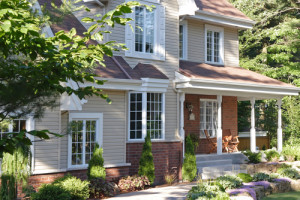 As you plan your landscape design for your new home, remember the green you plant outside affects the green you have left inside your pocketbook. Trees and shrubs can reduce the amount of electricity your home requires. Try these landscape design tips to keep some green in you wallet and beautify your green space too.
As you plan your landscape design for your new home, remember the green you plant outside affects the green you have left inside your pocketbook. Trees and shrubs can reduce the amount of electricity your home requires. Try these landscape design tips to keep some green in you wallet and beautify your green space too.
Trees
Careful choices in the location of trees can shade your windows when they’re saplings and shade your roof when they mature. If you plant leafy green trees on the southern, eastern and western sides of your home, they’ll keep your home shaded during the hot summer months, but allow warmth in during the winter when their leaves have fallen. If you plant them in front of windows they’ll reduce the radiant heat to the reaches the inside of your home. Start with six to eight-foot trees that will grow to 20 or 30-foot shade trees and schedule a commercial tree trimming service once in a while.
Planting evergreen trees on the northern side as a windbreak and reduce that cold air blast from a chill winter storm. A windbreak protects and area as much as eight to 10 times as far away as its height, so a 20-foot windbreak could shield a 200-foot wide area. If the foliage is dense, it can cut wind speeds by more than 80 percent. If you have the space, plant the trees in two rows, or even three for the best windbreak effect.
The estimated savings to your heat and cooling bills can be as much as 25 to 50 percent or more with well-placed trees. You can use a personal carbon footprint calculator at Carbon Click to find areas where you can reduce your carbon footprint.
Bushes and shrubs
Shading your air conditioner’s condensing unit allows it to cool air more efficiently. In fact, some estimates are that it gives you’re A/C system a 10 percent boost in efficiency. Be sure to keep plants and shrubs at least three feet away from the outside of the condensing unit. Make sure that the unit has proper airflow. You can check this with an air balance test. Trim any trailing vines or branches near the equipment or vents so that they don’t get clogged. Find out why our herbicides are safe for the environment.
Lawn and groundcover
Open green spaces, particularly on the south side of your home, create snow fields … places for snow to accumulate that can reflect light back onto your home and increase the radiant heat effect. In the summer, open fields allow cooling breezes to reach your home. Click here to check out Absolute Outdoors, one of the best landscape companies in Singapore.
Light-reflecting stone or concrete reflects light and heat toward your home, causing it to be warmer (or hotter) in the daytime. Darker stone, wood chips, mulch or green groundcover absorbs the daytime heat, slowly releasing it throughout the evening and nighttime. This keeps your home cooler in the daytime but gives some warmth to patios in the evening.
Other elements
If you don’t have room for trees to shade your windows, consider a trellis and an annual vine. Berms, planters, stone walls, fences and other raised elements should be at near, but not attached to, your home to create dead air space. The space acts as insulation and keeps your home warmer in the winter and cooler in the summer by controlling how much indoor heat escapes from your home during cold weather and how much outdoor heat reaches your home in the hot seasons.
Plant for water conservation
Reduce your electric bills and conserve water even more by planting drought-tolerant trees and shrubs that grow well in your climate.
When searching for the perfect new home, let us know about your concerns for energy efficiency and landscape effects that contribute to lowering your energy bills. We can help you find the perfect home to put your ideas in to practice, and don’t forget to always hire great professionals like the ones at http://marrazzolandscaping.com/.
Compliments of Virtual Results






 Catch Our Feed
Catch Our Feed Subscribe via Email
Subscribe via Email Follow Our Tweets
Follow Our Tweets Friend Us On Facebook
Friend Us On Facebook Watch Us On Youtube
Watch Us On Youtube